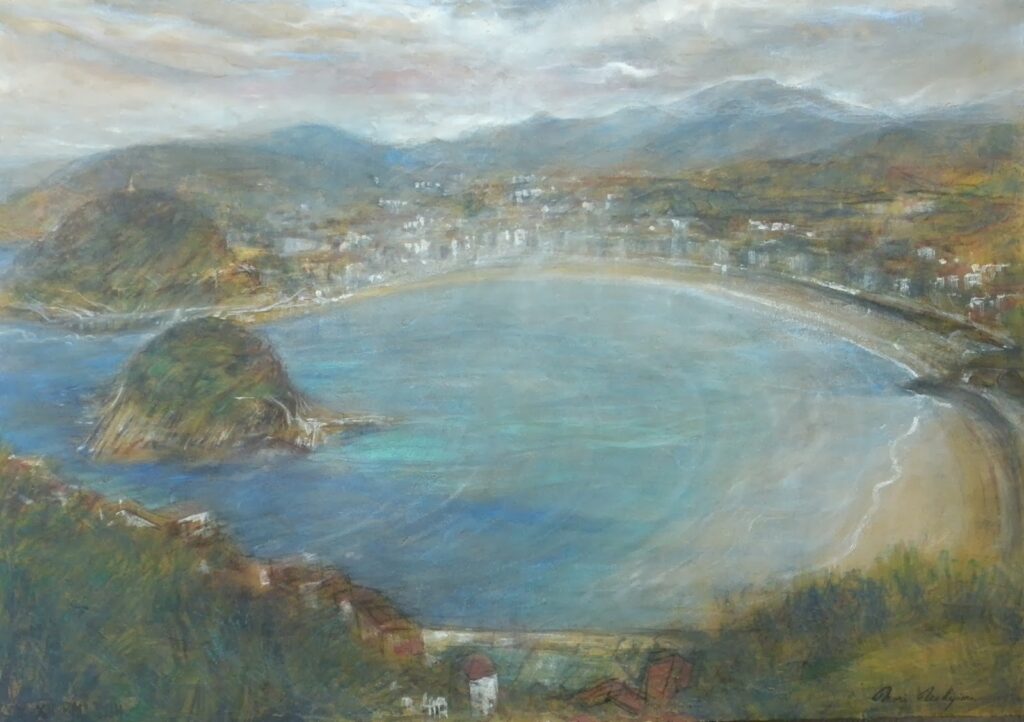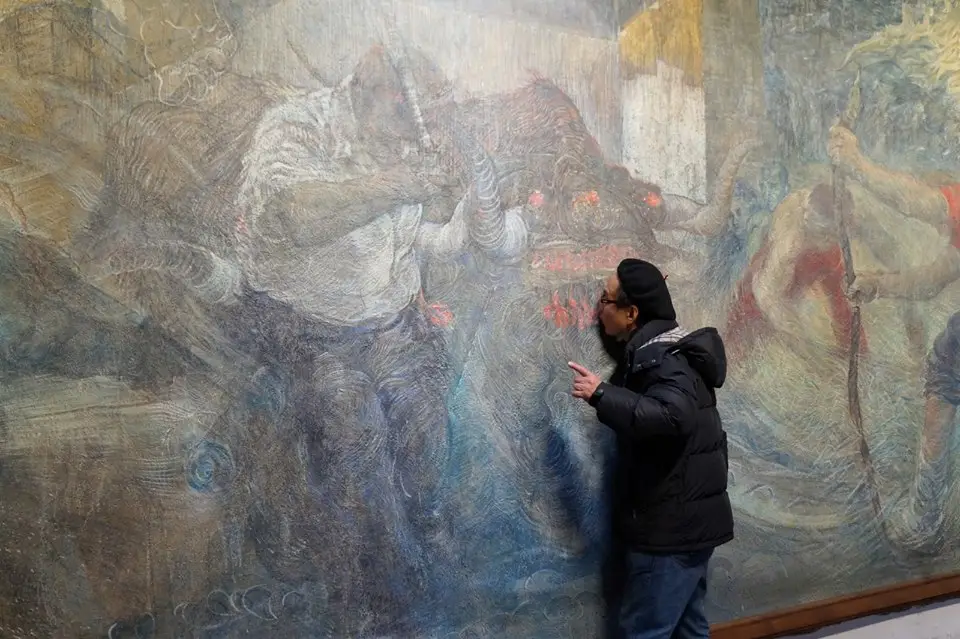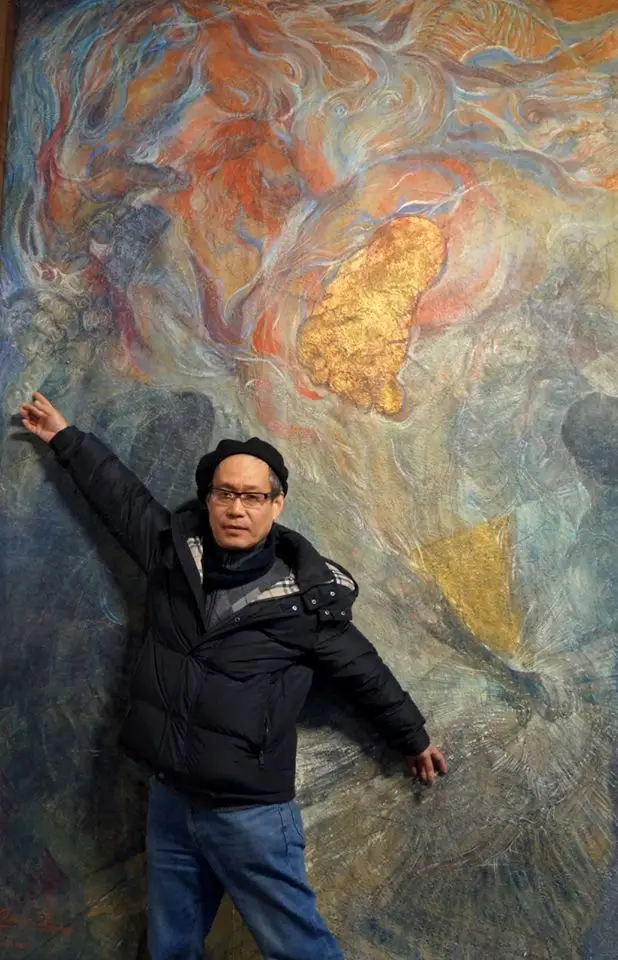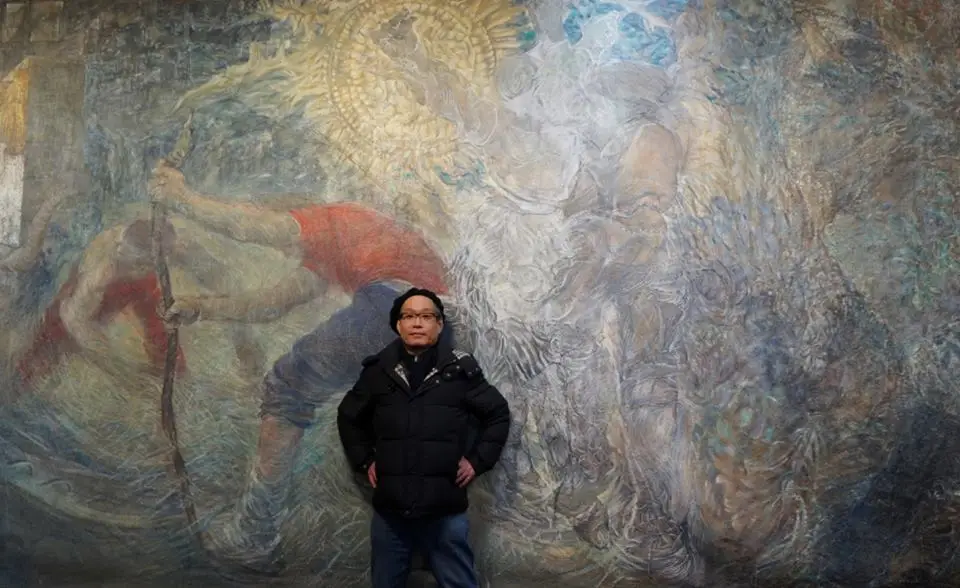Fresco
1.フレスコとは?
フレスコとは、砂と石灰を混ぜて作ったモルタルで壁を塗って、その上に水だけで溶いた顔料で、絵を描く方法です。 フレスコと他の絵画技法とで一番異なる所は、画面への絵具の定着を溶剤に頼らないということです。つまり、日本画の舊(にかわ)、油絵の油、水彩のノリ、といった溶剤をフレスコは一切必要としません。濡れた石灰の上に水溶きの顔料(粉末状の色素)を乗せてやれば、石灰水が顔料を覆い、空気中の二酸化炭素と反応して透明な結晶(カルサイト)になるのです。顔料はこの結晶に閉じ込められて美しさを保ち続けます。 そのためフレスコ画は、油絵や水彩画と全く違ったマチエール(画面の表情)を持っています。石灰がつくる結晶のなかに顔料の一粒一粒が閉じ込められるため、色が大変美しく、耐久性は抜群で非常に長期間(数千年)保たれます。
2. フレスコの歴史
バチカン市国のシスティーナ礼拝堂にあるミケランジェロが描いた「天地創造」、「最後の審判」は、近年の修復でことに有名になりましたが、これもフレスコ画です。ローマ時代に作られたポンペイの遺跡もフレスコ画の代表のひとつです。イタリアの教会に見られる壁画の多くがフレスコ画です。 また、ユーラシア大陸を東へ辿ると、石窟の壁に土や石灰を塗り、絵を描いたものが、キジルや敦煌の仏教遺跡にも見られます。また朝鮮半島の墳墓に見られる技法は、日本の高松塚古墳まで伝わってきています。 フレスコ画の歴史的作品は世界中で見る事ができます。そして現在もそれらと同じ方法で制作することができるのです。
3. フレスコの技法
フレスコという不思議な技法をマスターするには左官の技術も必要となりますが、生きた石灰と対話するのには魅力があります。石灰に定着していく顔料の美しさを含めて、一人でも多くの人にフレスコに接する機会を持ってほしいと思います。
◇ブオン・フレスコ◇
フレスコ画の代表的技法で、絵描きが一日に描き上げられる分だけの壁面を作り、その石灰が生乾きのうちに絵をかきあげ、毎日壁を塗り継いで絵を描いていく方法です。 *実寸下絵作り 実寸下絵を作るのは、基本的にやり直 しの効かないフレスコ画の特徴です。 準備段階で、完成イメージを鮮明にし ておくことが重要になります。 *壁作り 砂と消石灰を1:1から2:1の割合 でよく練ります。 地塗をして、乾いた ら一日に描ける分だけ上塗りします。 *転写・描画 壁がしまってきたら、下絵を壁に重ね て転写します。転写したら水で溶いた 顔料で着色します。また別の日に上塗 りを継ぎ足して描画、これをくり返し て完成に到ります。
Bahía de Donostia

* The requiest for groups visits at the villa is via this link: ARTEKO Gallery Tel: +34 943 297545
// e-mail: info@artekogallery.com
// url: https://artekogallery.com
Director: Cristina de la Fuente
* ヴィラへのグループ訪問に必要な情報は、次のリンクからお問い合わせください: ARTEKO Gallery 電話: +34 – 943 297 545
// 電子メール: info@artekogallery.com
/*デレクター: クリスティーナ・デ・ラ・フェンテ

フレスコ画の歴史と技法
■ Painting Techniques of the Renaissance:
Fresco painting has been around for a very long time, examples of the technique date back to at least 1500 BC. But the use of the medium became very prominent in the medieval and renaissance periods. There are three main painting mediums that were used in the renaissance, these are Fresco, (discussed here) Egg Tempera and Oil painting. There are varying types of fresco, true fresco or Buon fresco is very permanent and consists of brush painting onto freshly applied, wet lime plaster (referred to as the intonaco.) Using water as the medium the paint is absorbed into the plaster as it dries and the pigment is bound into the structure of the plaster. Wall painting was very popular in the renaissance era and fresco was the standard method of decoration. The area to be painted was first covered with an under layer of plaster named the arriccio. Often the artists would sketch their compositions on this under layer in a red pigment called sinopia. The artist could not make changes in the composition of the painting and had only the drying time of the plaster in which to complete his work (about 8 or 9 hours). Because of the drying time only enough intonaco was applied for a single days work. If mistakes were made the entire days layer of plaster would have to be removed. The giornata is the name given to a single days work and in fresco paintings the dividing lines between differing days work can very often be seen. These seems between the layers of plaster were often hidden by an application of Secco fresco.
*Secco fresco is used on dry plaster, pigment is applied using egg or size as the medium and also as a binder for the paint. In the secco fresco technique the paint is not absorbed into the structure of the plaster but forms a surface layer which tends to flake off and is therefore not so permanent as Buon fresco. Secco fresco is often used in conjunction with the buon method, secco is faster and allows for mistakes to be corrected.
* A mezzo-fresco, common at the end of the sixteenth century, was an intonaco that was painted when the surface was almost dry. The pigment only slightly penetrates the surface of the plaster retaining much of the colour that varied considerably when painting into wet plaster. Artists of the renaissance worked in slightly different ways when working in fresco. Typically the artist would work from a top corner of the painting and gradually apply the paint from top to bottom, working a stage each day until completion. This method avoided damaging or splattering finished sections with paint. Instead of using the red pigment sinopia for the under painting many artists used preparatory drawings on paper. The drawings would be held against the wall and the main lines pricked through, a bag of soot would be banged along the holes producing dots giving the outline of the work. Given that fresco painting did not allow mistakes to be easily rectified, the drawings became important in producing a coherent composition for the finished work. //
— en Mendaro.
ルネサンスの絵画技術:
フレスコ画は非常に長い間存在しており、その技術の例は少なくとも紀元前 1500 年にまで遡ります。しかし、この媒体の使用は中世とルネサンスの時代に非常に顕著になりました。ルネサンスで使用された主な絵画媒体は 3 つあり、フレスコ画、エッグ テンペラ (ここで説明します)、油彩です。フレスコ画にはさまざまな種類がありますが、真のフレスコ画またはブオン フレスコ画は非常に永続的なもので、塗りたての濡れた石灰漆喰 (イントナコと呼ばれます) に筆でペイントすることで構成されます。媒体として水を使用し、乾燥するにつれて絵の具が漆喰に吸収されます。そして顔料は石膏の構造に結合します。ルネッサンス時代には壁画が非常に人気があり、フレスコ画が標準的な装飾方法でした。塗装する領域は、最初にアリッチョと呼ばれる漆喰の下層で覆われました。多くの場合、芸術家はシノピアと呼ばれる赤い顔料でこの下層に構図をスケッチします。芸術家は絵の構成を変更することができず、石膏の乾燥時間だけで作品を完成させることができました(約 8 ~ 9 時間)。乾燥に時間がかかるため、1 日の作業に必要な量のイントナコしか塗布されませんでした。間違いを犯した場合は、丸一日かけて石膏の層を除去する必要があります。ジョルナータは 1 日の作業に与えられた名前であり、フレスコ画では、異なる日の作業間の境界線がよく見られます。これらは石膏の層の間にあるように見え、多くの場合、セッコのフレスコ画を適用することで隠されていました。
*セッコフレスコ画は乾いた石膏の上に使用され、顔料は卵またはサイズを媒体として、また絵具のバインダーとして使用して塗布されます。セッコのフレスコ画技法では、塗料は石膏の構造に吸収されず、剥がれ落ちやすい表面層を形成するため、ブオンのフレスコ画ほど永続的ではありません。
Secco fresco は、優れた方法と組み合わせて使用されることが多く、secco の方が高速で、間違いを修正できます。 * 16世紀末に一般的だったメゾ・フレスコ画は、表面がほぼ乾いた状態で描かれたイントナコでした。顔料は漆喰の表面にわずかに浸透するだけで、湿った漆喰にペイントすると大幅に変化する色の多くが残ります。ルネッサンスの芸術家たちは、フレスコ画を制作する際に、少し異なる方法で制作しました。通常、芸術家は絵の上隅から作業し、上から下に徐々に絵の具を塗布し、完成するまで毎日 1 段階ずつ作業します。この方法により、完成した部分に損傷を与えたり、塗料が飛び散ったりすることがなくなりました。下絵に赤い顔料シノピアを使用する代わりに、多くの芸術家は紙に下絵を描きました。図面を壁に当てて主線を刺し、煤の入った袋を穴に沿って叩き、作品の輪郭を与える点を生成します。フレスコ画では間違いを簡単に修正できないため、完成した作品の一貫した構成を生み出すために図面が重要になりました。 //
バスク地方の伝統的なスポーツへのトリビュート
Author: Nori Ushijima // Title: Tribute to BasqueCountry´s customary sport // Technique: Fresco+ egg temepera,oli and resin on canvas
Location: in the villa Berasaluce (Mendaro / Basque Country / Spain) // Dimensions:300x1400cm // Completion Date: 2006 //



Mi pintura( temple al huevo y a la caseína+ óleo+fresco+esgrafiado+